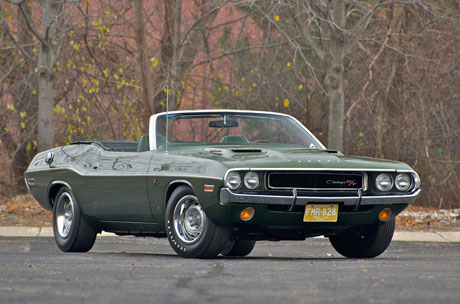SCM Analysis
Detailing
| Vehicle: | 1970 Dodge Challenger R/T Hemi Convertible |
| Years Produced: | 1970 |
| Number Produced: | Nine for United States, three for export |
| Original List Price: | $4,900 |
| SCM Valuation: | $450k to $650k |
| Tune Up Cost: | $1,000 |
| Distributor Caps: | $20 |
| Chassis Number Location: | On dash VIN tag, driver's door jamb decal, fender tag on left inner fender, well under hood, stamped on left side on cowl and back left side of radiator core support. |
| Engine Number Location: | Passenger side of engine block, on machined pad above oil pan rail and in front of motor mount |
| Club Info: | WPC Club |
| Website: | http://www.chryslerclub.org |
| Alternatives: | 1970-71 Hemi 'Cuda convertible, 1970 Chevelle LS-6 convertible, Mopar B Body Hemi convertibles |
| Investment Grade: | A |
This car sold for $750,000 post-block at Dana Mecum’s Spring Classic Auction, held May 19-23, 2010 in Indianapolis, IN. (The car sold in what Mecum refers to as their “The Bid Goes On” process).
Wait, 750 Big Ones for a green-on-green, automatic Challenger? Welcome to the funhouse mirror world of Mopar Hemi E-Body (Dodge Challenger and Plymouth Barracuda) drop tops.
As what most consider the poster children for muscle car era excess, Hemi E Body convertibles were so ridiculous when new that few actually ordered them. This makes them one of the rarest muscle cars of all. It wasn’t that Chrysler didn’t want to sell a lot of them to protect future values. It is a simple fact that, even in 1970, buyers knew that 425 hp in a car with barely enough torsional rigidity to handle the base six-cylinder motor was not a wise choice.
These things were like a toboggan on steroids, with chassis flex to the point that doors were known to pop open under hard acceleration. And the convertible top added weight and complexity, which was not a good thing for racers— who were the target demographic for Hemi cars.
Muscle car values soar and crash
Just 41 Hemi E Body convertibles were built in two years of production during 1970 and 1971. Nine of them were Challengers for the United States market, and this car is one of the nine. As the poster child for the muscle market, these have been the barometer for muscle car values since 2002, when a 1971 ‘Cuda was the first muscle car to break the two-comma barrier with a $1m sale. Hemi ‘Cuda convertibles then led the charge in the muscle car value race, with one eventually being reported sold for a cool $4m. Think of these as the 250 GTO or 275 GTB/4 of the muscle car market. They lead, others follow.
And leaders will travel upwards and downwards.
We all know that the muscle car values have been returning to earth over the last few years, with hot tiles popping off the ship just like the Space Shuttle upon re-entry. Think of those tiles as the lesser cars that were not worthy of the big numbers people were paying for them. Clones and fakey-dos are the most obvious, but so are the multi-million-dollar Hemi convertibles. All of this spurred a drop in Hemi values across the board. It is generally accepted that if “That thing has got a Hemi in it,” then its value is down roughly 30 to 50 percent from the outer-space heights in 2006 and 2007.
Using that math, let’s examine the subject car:
Making it valuable is the one-of-nine status, a verifiable and documented history, the original drivetrain, and Roger Gibson’s award-winning restoration. Gibson is to Mopar cars what Wayne Obrey’s Motion Products is to Ferraris, or Paul Russell is to Mercedes-Benz 300SLs.
Detracting from the car’s value is a very tough color combination of dark green with a green interior—and the lack of that third pedal and that lever you use to manually select one of 4 speeds. With muscle cars, it is a close race between which is more important to value: a 4-speed or a “good” (bright and obnoxious) color. In this case the car has neither.
Bought on the fall back to Earth
At the peak, this car would have brought between $1m to $1.5m—in my estimation. In 2008, a Plum Crazy Purple 4-speed Hemi Challenger convertible sold in a confirmed private sale for $1m.
Using our correction factor from above, that puts this $750k sale right on the money. For his 750 Big Ones, the buyer purchased a known quantity, with an impeccable restoration, at a large discount from the 2005-2007 cost of admission to the Hemi E Body Convertible Club.
The seller, if he had purchased the car prior to the rocket-ship rise of Hemi values, achieved a higher price than anybody would have thought possible at the beginning of the century. I’d call this a fair and predictable result all around, and both buyer and seller should be very pleased.

Pingback: Beautiful And Extremely Rare Dodge Vehicles Most People Didn't Know Existed
Pingback: Holy Grails: Ultra-Rare Muscle Cars Produced In Single Digits – Motor Junkie
Pingback: Holy Grails: Classic Muscle Cars With Single-Digit Production Numbers – Motor Junkie